2006 TOYOTA RAV4 2gr
[x] Cancel search: 2grPage 561 of 2000

2GR-FE ENGINE CONTROL SYSTEM – SFI SYSTEMES–37
ES
HINT:
*: The ECM terminal voltage is constant regardless
of the output voltage from the sensor.
(b) WAVEFORM 1
Camshaft timing oil control valve (OCV)
PPMP (B30-77) - EPPM (B30-76) L - BR Canister pressure sensor
(built into canister pump
module)Ignition switch ON 3 to 3.6 V
ELS (A9-31) - E1 (B30-81) O - BR Electric load Taillight switch ON7.5 to 14 V
Taillight switch OFF Below 1.5 V
ELS2 (A9-33) - E1 (B30-81) G - BR Electric load Defogger switch ON7.5 to 14 V
Defogger switch OFF Below 1.5 V
ALT (B30-32) - E1 (B30-81) P - BR Generator Ignition switch ON 9 to 14 V
CANH (A9-41) - E1 (B30-81) Y - BR CAN communication line Ignition switch ON Pulse generation (see
waveform 12)
CANL (A9-49) - E1 (B30-81) W - BR CAN communication line Ignition switch ON Pulse generation (see
waveform 13)
VCIB (B30-80) - EIB (B30-101) LG - P Battery current sensor Ignition switch ON 4.5 to 5.5 V
IB (B30-100) - EIB (B30-101) R - P Battery current sensor Ignition switch ON 0.5 to 2.5 V
THB (B30-103) - EIB (B30-101) G-R - P Battery temperature
sensorIgnition switch ON, battery
temperature -30 to 80
C (-22 to
176
F)0.5 to 4.5 V
RLO (B30-31) - E1 (B30-81) Y - BR Generator After engine warmed up, during
charging control, vehicle driven at
constant speedPulse generation (see
waveform 14)
RLO (B30-31) - E1 (B30-81) Y - BR Generator After engine warmed up, during
charging control, vehicle
acceleratedPulse generation (see
waveform 15)
RLO (B30-31) - E1 (B30-81) Y - BR Generator After engine warmed up, during
charging control, vehicle
deceleratedPulse generation (see
waveform 16)
AICV (A9-4) - E1 (B30-81) L - BR VSV for air intake control
system operation signalIgnition switch ON 9 to 14 V
ACIS (B30-107) - E1 (B30-81) R - BR VSV for ACIS (Acoustic
Control Induction System)
operation signalIgnition switch ON 9 to 14 V Symbol (Terminal No.) Wiring Color Terminal Description Condition Specified Condition
A093229E02
Symbol (Terminal No.) Between OC1+ and OC1-
Between OC2+ and OC2-
Between OE1+ and OE1-
Between OE2+ and OE2-
Tester Range 5 V/DIV., 1 msec./DIV.
Condition Idling
Page 562 of 2000

ES–382GR-FE ENGINE CONTROL SYSTEM – SFI SYSTEM
ES
(c) WAVEFORM 2
Heated oxygen sensor
HINT:
In DATA LIST, item O2S B1 S2 shows the ECM
input values from the heated oxygen sensor.
(d) WAVEFORM 3
Injector No. 1 (to No. 4) injection signal
HINT:
The wavelength becomes shorter as the engine rpm
increases.
(e) WAVEFORM 4
Knock sensor
HINT:
• The wavelength becomes shorter as the engine
rpm increases.
• The waveforms and amplitudes displayed differ
slightly depending on the vehicle.
(f) WAVEFORM 5
Crankshaft position sensor and Camshaft
position sensor
HINT:
The wavelength becomes shorter as the engine rpm
increases.
A088863E05
Symbol (Terminal No.) Between OX1B and EX1B
Between OX2B and EX2B
Tester Range 0.2 V/DIV., 200 msec./DIV.
Condition Engine speed maintained at 2,500 rpm
for 2 minutes after warming up sensor
A093279E04
Symbol (Terminal No.) Between #10 (to #60) and E01
Tester Range 20 V/DIV., 20 msec./DIV.
Condition Idling
A085286E03
Symbol (Terminal No.) Between KNK1 and EKNK
Between KNK2 and EKN2
Tester Range 1 V/DIV., 1 msec./DIV.
Condition Engine speed maintained at 4,000 rpm
after warming up engine
A122767E04
Symbol (Terminal No.) Between NE+ and NE-
Between VV1+ and VV1-
Between EV1+ and EV1-
Between VV2+ and VV2-
Between EV2+ and EV2-
Tester Range 5 V/DIV., 20 msec./DIV.
Condition Idling
Page 563 of 2000
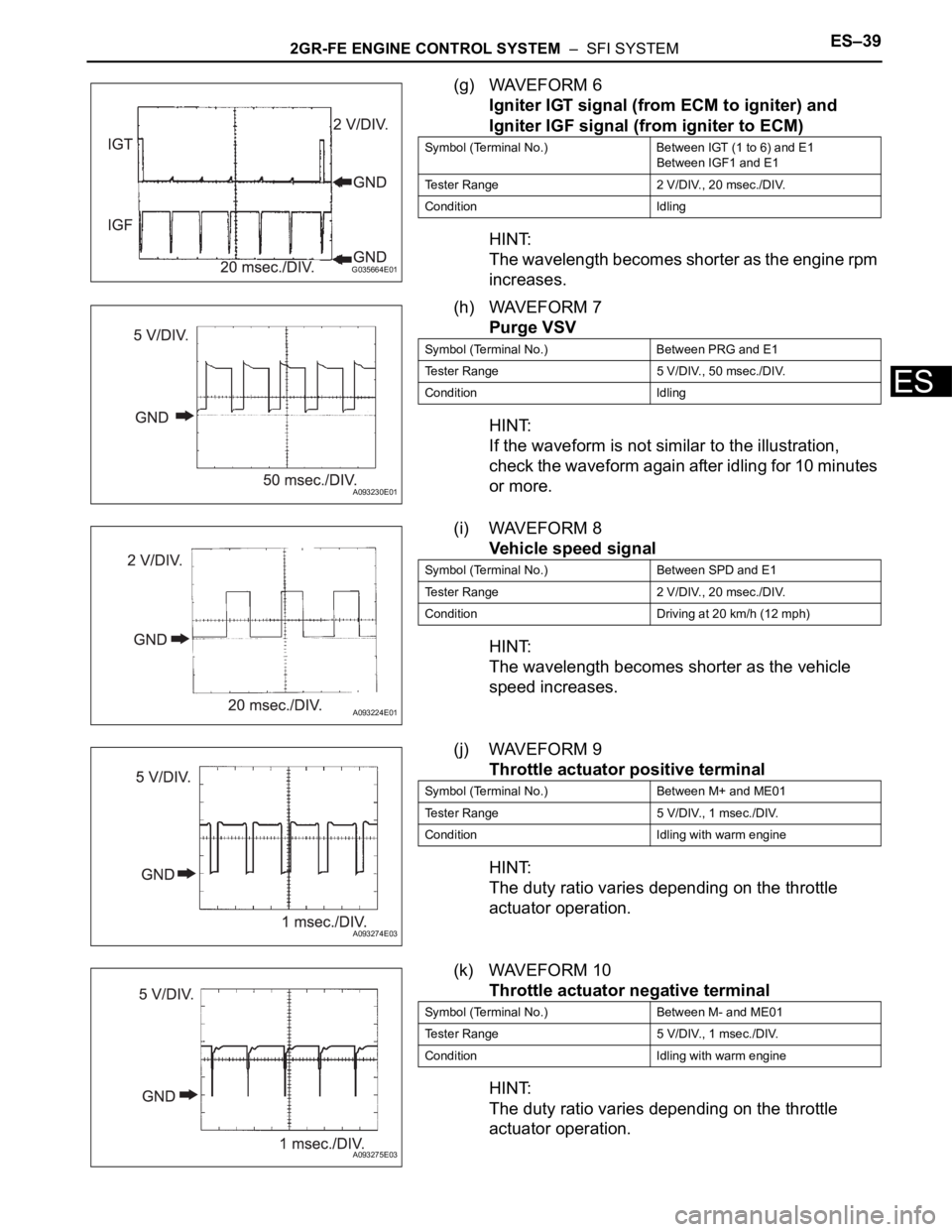
2GR-FE ENGINE CONTROL SYSTEM – SFI SYSTEMES–39
ES
(g) WAVEFORM 6
Igniter IGT signal (from ECM to igniter) and
Igniter IGF signal (from igniter to ECM)
HINT:
The wavelength becomes shorter as the engine rpm
increases.
(h) WAVEFORM 7
Purge VSV
HINT:
If the waveform is not similar to the illustration,
check the waveform again after idling for 10 minutes
or more.
(i) WAVEFORM 8
Vehicle speed signal
HINT:
The wavelength becomes shorter as the vehicle
speed increases.
(j) WAVEFORM 9
Throttle actuator positive terminal
HINT:
The duty ratio varies depending on the throttle
actuator operation.
(k) WAVEFORM 10
Throttle actuator negative terminal
HINT:
The duty ratio varies depending on the throttle
actuator operation.
G035664E01
Symbol (Terminal No.) Between IGT (1 to 6) and E1
Between IGF1 and E1
Tester Range 2 V/DIV., 20 msec./DIV.
Condition Idling
A093230E01
Symbol (Terminal No.) Between PRG and E1
Tester Range 5 V/DIV., 50 msec./DIV.
Condition Idling
A093224E01
Symbol (Terminal No.) Between SPD and E1
Tester Range 2 V/DIV., 20 msec./DIV.
Condition Driving at 20 km/h (12 mph)
A093274E03
Symbol (Terminal No.) Between M+ and ME01
Tester Range 5 V/DIV., 1 msec./DIV.
Condition Idling with warm engine
A093275E03
Symbol (Terminal No.) Between M- and ME01
Tester Range 5 V/DIV., 1 msec./DIV.
Condition Idling with warm engine
Page 564 of 2000
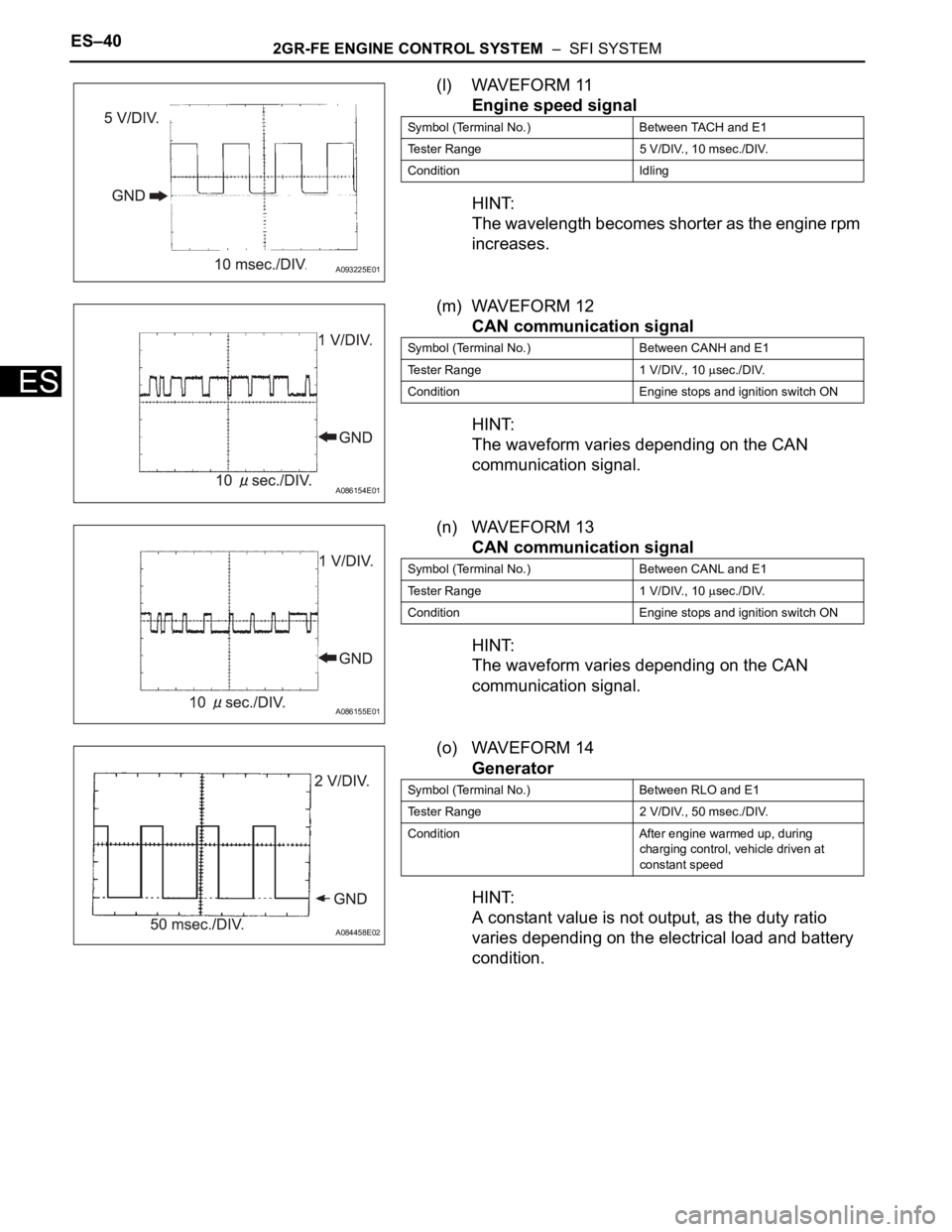
ES–402GR-FE ENGINE CONTROL SYSTEM – SFI SYSTEM
ES
(l) WAVEFORM 11
Engine speed signal
HINT:
The wavelength becomes shorter as the engine rpm
increases.
(m) WAVEFORM 12
CAN communication signal
HINT:
The waveform varies depending on the CAN
communication signal.
(n) WAVEFORM 13
CAN communication signal
HINT:
The waveform varies depending on the CAN
communication signal.
(o) WAVEFORM 14
Generator
HINT:
A constant value is not output, as the duty ratio
varies depending on the electrical load and battery
condition.
A093225E01
Symbol (Terminal No.) Between TACH and E1
Tester Range 5 V/DIV., 10 msec./DIV.
Condition Idling
A086154E01
Symbol (Terminal No.) Between CANH and E1
Tester Range 1 V/DIV., 10
sec./DIV.
Condition Engine stops and ignition switch ON
A086155E01
Symbol (Terminal No.) Between CANL and E1
Tester Range 1 V/DIV., 10
sec./DIV.
Condition Engine stops and ignition switch ON
A084458E02
Symbol (Terminal No.) Between RLO and E1
Tester Range 2 V/DIV., 50 msec./DIV.
Condition After engine warmed up, during
charging control, vehicle driven at
constant speed
Page 565 of 2000
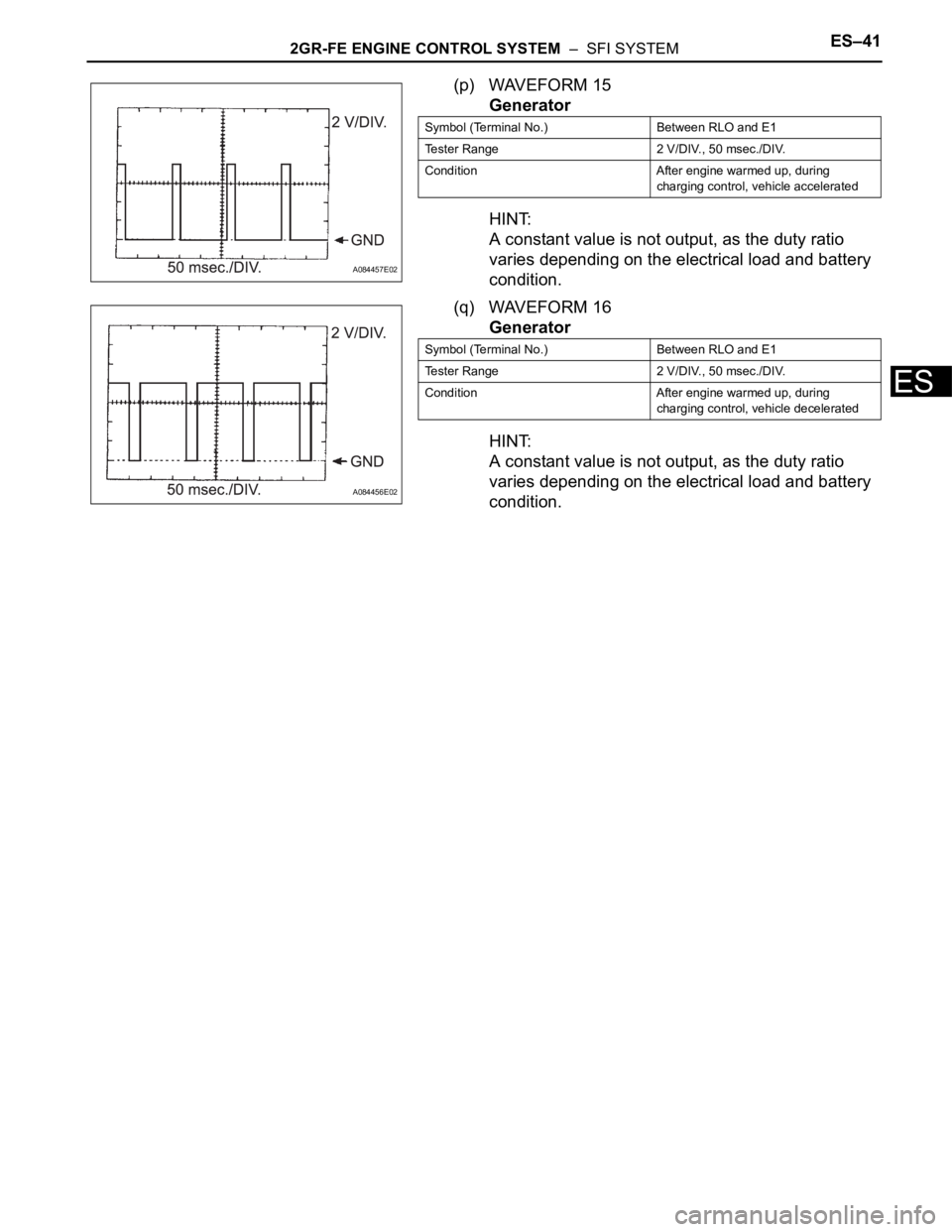
2GR-FE ENGINE CONTROL SYSTEM – SFI SYSTEMES–41
ES
(p) WAVEFORM 15
Generator
HINT:
A constant value is not output, as the duty ratio
varies depending on the electrical load and battery
condition.
(q) WAVEFORM 16
Generator
HINT:
A constant value is not output, as the duty ratio
varies depending on the electrical load and battery
condition.
A084457E02
Symbol (Terminal No.) Between RLO and E1
Tester Range 2 V/DIV., 50 msec./DIV.
Condition After engine warmed up, during
charging control, vehicle accelerated
A084456E02
Symbol (Terminal No.) Between RLO and E1
Tester Range 2 V/DIV., 50 msec./DIV.
Condition After engine warmed up, during
charging control, vehicle decelerated
Page 566 of 2000

ES–422GR-FE ENGINE CONTROL SYSTEM – SFI SYSTEM
ES
DIAGNOSIS SYSTEM
1. DESCRIPTION
When troubleshooting OBD II (On-Board Diagnostics)
vehicles, the intelligent tester (complying with SAE
J1987) must be connected to the DLC3 (Data Link
Connector 3) of the vehicle. Various data in the vehicle's
ECM (Engine Control Module) can be then read.
OBD II regulations require that the vehicle's on-board
computer illuminate the MIL (Malfunction Indicator
Lamp) on the instrument panel when the computer
detects a malfunction in:
(a) The emission control system components.
(b) The powertrain control components (which affect
vehicle emissions).
(c) The computer itself.
In addition, if the applicable DTCs (Diagnostic Trouble
Codes) prescribed by SAE J2012 are not recorded on 3
consecutive trips, the MIL turns off automatically but the
DTCs remain recorded in the ECM memory.
To check DTCs, connect the intelligent tester to the
DLC3. The tester displays DTCs, freeze frame data, and
a variety of the engine data. The DTCs and freeze frame
data can be erased with the tester (see page ES-39).
In order to enhance OBD function on vehicles and
develop the Off-Board diagnosis system, CAN
(Controller Area Network) communication is introduced
in this system. It minimizes the gap between technician
skills and vehicle technology. CAN is a network, which
uses a pair of data transmission lines, spanning multiple
computers and sensors. It allows high speed
communication between the systems and simplifies the
wire harness connection.
Since this system is equipped with the CAN
communication, connecting the CAN VIM (Vehicle
Interface Module) to the intelligent tester is necessary to
display any information from the ECM. (Also the
communication between the intelligent tester and the
ECM uses CAN communication signals.) When
confirming the DTCs and any data of the ECM, connect
the CAN VIM between the DLC3 and the intelligent
tester.
2. NORMAL MODE AND CHECK MODE
The diagnosis system operates in normal mode during
normal vehicle use. In normal mode, 2 trip detection
logic is used to ensure accurate detection of
malfunctions. Check mode is also available as an option
for technicians. In check mode, 1 trip detection logic is
used for simulating malfunction symptoms and
increasing the system's ability to detect malfunctions,
including intermittent problems (intelligent tester only)
(see page ES-42).
FI00534E01
B127989E01
Page 567 of 2000
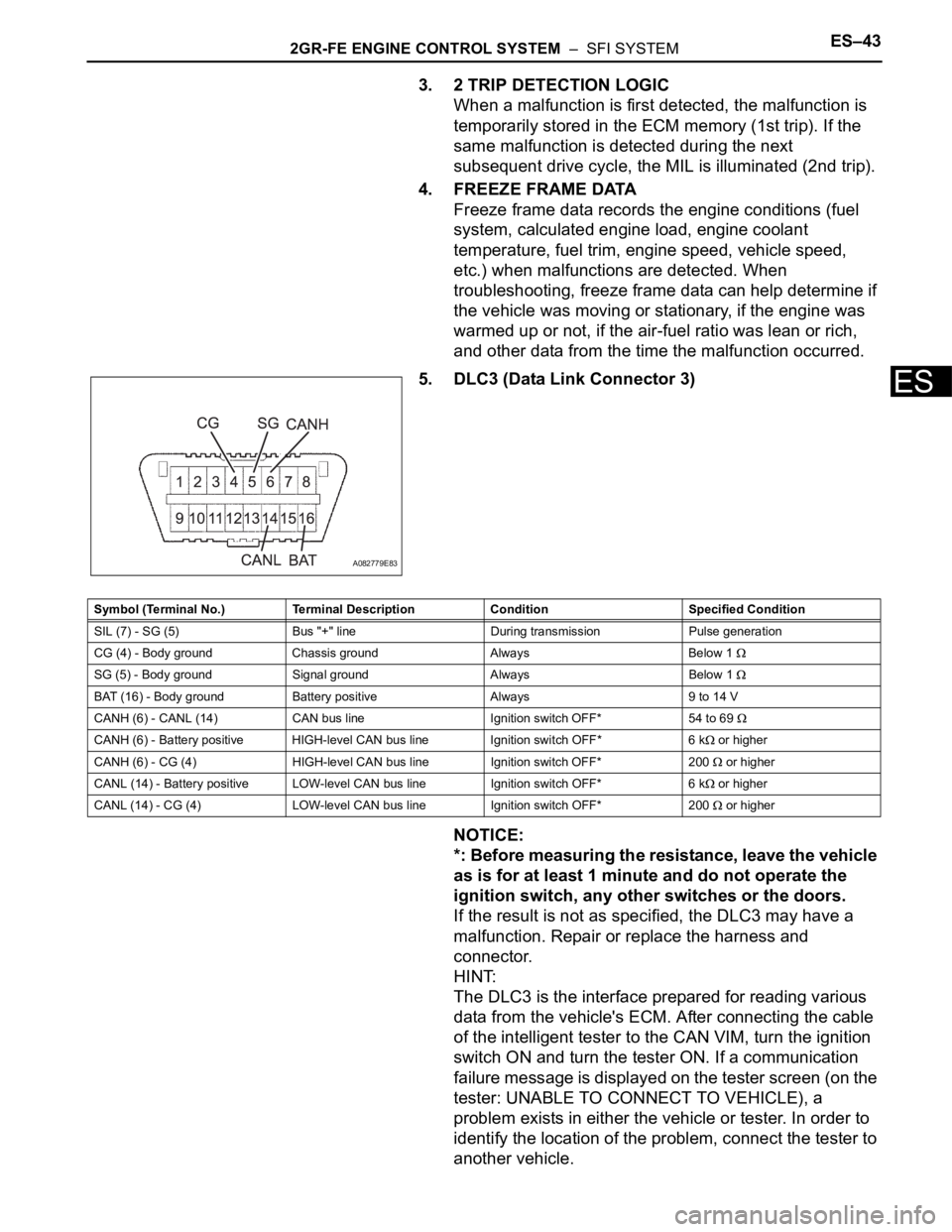
2GR-FE ENGINE CONTROL SYSTEM – SFI SYSTEMES–43
ES
3. 2 TRIP DETECTION LOGIC
When a malfunction is first detected, the malfunction is
temporarily stored in the ECM memory (1st trip). If the
same malfunction is detected during the next
subsequent drive cycle, the MIL is illuminated (2nd trip).
4. FREEZE FRAME DATA
Freeze frame data records the engine conditions (fuel
system, calculated engine load, engine coolant
temperature, fuel trim, engine speed, vehicle speed,
etc.) when malfunctions are detected. When
troubleshooting, freeze frame data can help determine if
the vehicle was moving or stationary, if the engine was
warmed up or not, if the air-fuel ratio was lean or rich,
and other data from the time the malfunction occurred.
5. DLC3 (Data Link Connector 3)
NOTICE:
*: Before measuring the resistance, leave the vehicle
as is for at least 1 minute and do not operate the
ignition switch, any other switches or the doors.
If the result is not as specified, the DLC3 may have a
malfunction. Repair or replace the harness and
connector.
HINT:
The DLC3 is the interface prepared for reading various
data from the vehicle's ECM. After connecting the cable
of the intelligent tester to the CAN VIM, turn the ignition
switch ON and turn the tester ON. If a communication
failure message is displayed on the tester screen (on the
tester: UNABLE TO CONNECT TO VEHICLE), a
problem exists in either the vehicle or tester. In order to
identify the location of the problem, connect the tester to
another vehicle.
A082779E83
Symbol (Terminal No.) Terminal Description Condition Specified Condition
SIL (7) - SG (5) Bus "+" line During transmission Pulse generation
CG (4) - Body ground Chassis ground Always Below 1
SG (5) - Body ground Signal ground Always Below 1
BAT (16) - Body ground Battery positive Always 9 to 14 V
CANH (6) - CANL (14) CAN bus line Ignition switch OFF* 54 to 69
CANH (6) - Battery positive HIGH-level CAN bus line Ignition switch OFF* 6 k or higher
CANH (6) - CG (4) HIGH-level CAN bus line Ignition switch OFF* 200
or higher
CANL (14) - Battery positive LOW-level CAN bus line Ignition switch OFF* 6 k
or higher
CANL (14) - CG (4) LOW-level CAN bus line Ignition switch OFF* 200
or higher
Page 568 of 2000
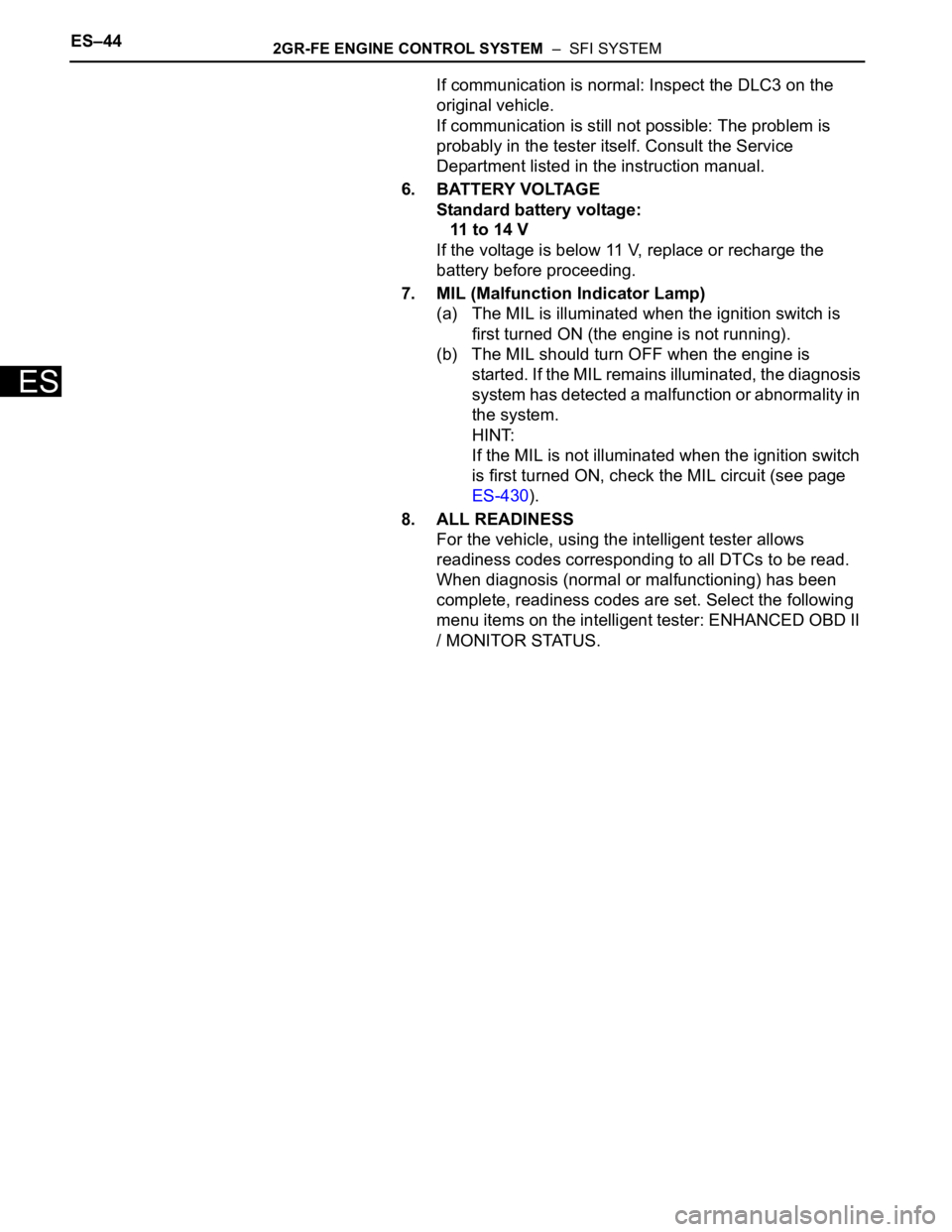
ES–442GR-FE ENGINE CONTROL SYSTEM – SFI SYSTEM
ES
If communication is normal: Inspect the DLC3 on the
original vehicle.
If communication is still not possible: The problem is
probably in the tester itself. Consult the Service
Department listed in the instruction manual.
6. BATTERY VOLTAGE
Standard battery voltage:
11 to 14 V
If the voltage is below 11 V, replace or recharge the
battery before proceeding.
7. MIL (Malfunction Indicator Lamp)
(a) The MIL is illuminated when the ignition switch is
first turned ON (the engine is not running).
(b) The MIL should turn OFF when the engine is
started. If the MIL remains illuminated, the diagnosis
system has detected a malfunction or abnormality in
the system.
HINT:
If the MIL is not illuminated when the ignition switch
is first turned ON, check the MIL circuit (see page
ES-430).
8. ALL READINESS
For the vehicle, using the intelligent tester allows
readiness codes corresponding to all DTCs to be read.
When diagnosis (normal or malfunctioning) has been
complete, readiness codes are set. Select the following
menu items on the intelligent tester: ENHANCED OBD II
/ MONITOR STATUS.